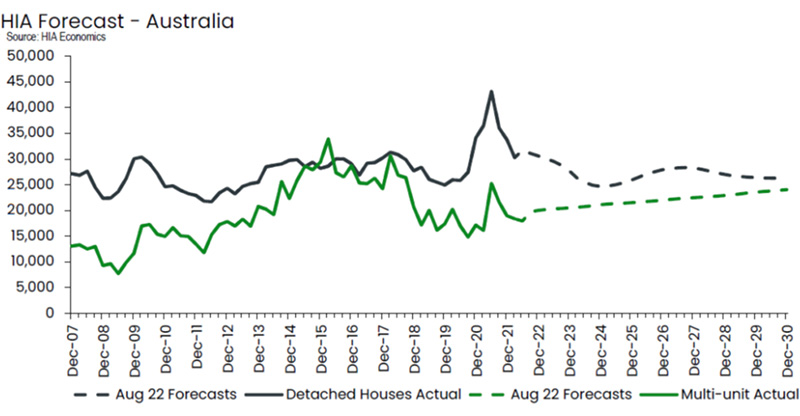Builders urged to dig in for tough year ahead
A select group of construction and finance industry directors have shared with API Magazine the secrets that help building companies stay in business while others around them capitulate.
A combination of Covid-19, rising costs of labour and material, extreme weather events, contractual lock-ins eroded by inflation and, in some cases, greed, initiated the collapse of more than 30 construction businesses since the beginning of the pandemic.
Interest rate increases have now exacerbated an already precarious situation for those companies that survived the pandemic onslaught, with a tougher finance landscape heaping pressure on those builders struggling to stay competitive in the industry.
RSM Australia’s National Director of Property and Construction, Adam Crowley, predicts the construction industry is approaching an undeniably tough year.
“It is more important than ever for property and construction businesses to ensure they have robust systems in place to survive,” Mr Crowley said.
“Construction firms have faced issue after issue; from Covid impacting on-site work, to supply chain delays, increased material costs and shortages due to a scarcity of labour.
“While Covid’s impact lessens, these other issues have been compounded by bad weather, and so, a large amount of uncertainty remains in the industry,” Mr Crowley said.
His comments coincided with the collapse this week of a major builder in Sydney, EQ Constructions, and a couple more in Perth.
Tim Reardon, Chief Economist, Housing Industry Association (HIA) said the scenario faced by the building industry is best encapsulated by the bull-whip effect, which has been accelerated by international crises that continue to wreak havoc on Australia’s housing sector .
“Commencement numbers are forecast to contract over the next three years from the record 131,730 in 2021-22 before bottoming out at historically respectable levels of 99,330 in 2024-25.
“The low point in activity is expected to be around the December quarter of 2024 or the March quarter of 2025,” he said.

2023 building industry predictions
Figliomeni Constructions’ Director, Stephen Figliomeni, believes the delayed projects caused by pandemic lockdowns will be cleared in 2023.
This will relieve some pressure on profit margins and improve cash flows for many industry players, however, rises in materials and costs will remain a big challenge for builders for at least the rest of the year, he said.
“We anticipate the cost of labour will remain stable in 2023 but foresee some rises in the costs of materials,” Mr Figliomeni predicted.

Stephen Figliomeni, Director and Nat Figliomeni, Managing Director, Figliomeni Constructions.
“Many Covid-19 contracts that were due to be completed in 2020-21 will see the finish line in 2023, releasing some stress on material supplies and cash flow, and returning some confidence of a brighter future for the industry later this year,” he said.
Director of Group One Construction, Darren Rullo, looks at 2023 as a possibly bright year for medium-sized building companies.
“The focus has switched from a 'get rich now and fix later' mindset to demonstrating competency and gaining trust from clients and suppliers,” Mr Rullo explained.
“It has never been more important to have capable and knowledgeable people on site.
“Accountability for workmanship needs to be maintained and enforced to stay competitive in business.
“It is pivotal to keep a close eye on the building process and have established trust with quality tradesmen who have proved their workmanship in the past.
“The problem is that good people are hard to find and there is a significant amount of pressure and responsibility put on builders and subcontractors.”
He said that with price pressure such a major driver for builders and clients alike, the cheapest quote would normally win the job.
“And, as we all know, cheapest is usually not the best.
“I feel this is where we’re seeing the collapse of big and small companies who are competing in price war markets, lowering prices to win the job, only to get hit with price increases later,” Mr Rullo said.
Michelle Shackles, Director of insolvency specialists BRI Ferrier, has worked as administrator for some of the construction businesses that collapsed.

Michelle Shackles, Director, BRI Ferrier.
“From a consumer perspective, there is the added complication of purchasing an insurance policy to assist the consumer should the builder fail, however, this leaves little incentive to negotiate any price increases on a fixed price contract,” she said.
“Success in the building industry is largely driven by accurate costings and profit margins are a finite number.
“Significant price increases across materials and labour will quickly diminish that margin,” Ms Shackles said.
“It’s imperative,” she continued, “that costings across contracts are accurately quantified to take into account price increases.
“Businesses in the building industry must consider how recent price increases may not necessarily be a short-term problem and think strategically in view of future contracts.
“It may sometimes be better to decline a contract.
“Historically, we have seen builders funding cash flow based on future work, a practice that is no longer viable nor sustainable, particularly in the current environment.”
How to survive when so many building companies fall
Mr Figliomeni believes the secret to the success of a building company is education of its stakeholders.
“The industry needs to educate their clients to realise these price rises are real and have affected businesses of all sizes.
“Unless these price rises are passed on to the end-user, building companies will inevitably fall.

Darren Rullo, Director, Group One Construction.
“It is up to the building company to review its structure, and ensure prices are based on the current costs of labour and materials, and allow for increases.”
Mr Rullo explained that greed is a big problem in the industry.
“When you take on more projects than you can deliver you put so much pressure on your business, which could result in losing your structure and the larger picture,” Mr Rullo said.
“Knocking back some projects might not bring in as much money as I initially planned on, however, I’m mitigating risk and I don’t want to be stuck with contracts I cannot deliver on time,” he said.
As liquidators, Ms Shackles shared some advice for building companies to help them survive in the current conditions.
“The key takeaway is to ensure your costing structure is reviewed regularly and accurately, particularly given the increasing interest rate environment.
“Ensure the business has appropriately qualified people to undertake this, and that a string of loss-making contracts is not diminishing the working capital position of the business.
“As a director, know your skill set and where skills are lacking and ensure you have complementary staff and advisors around you.”





















